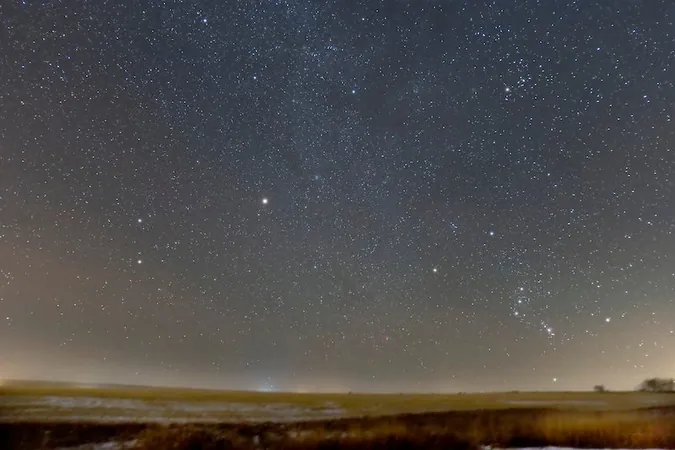
October 2024: The Sky Awaits Your Gaze! Unlock the Mysteries of the Universe This Month!
2024-10-01
As October unfolds, the night sky becomes a spectacle worth exploring.
In the evening twilight, Mercury and the radiant Venus can be spotted, with Venus shining like a brilliant beacon at magnitude -3.9, making it the star of the season. Although Mercury is shy and difficult to catch—particularly as it slips below the horizon—it offers a unique challenge for stargazers. Keep an eye on Mercury as it brightens throughout the month, reaching an elongation of 18° east of the Sun by Halloween.
Don't Miss Comet C/2023 A3 (Tsuchinshan-ATLAS) – It's Coming!
Mid-October will serve a celestial treat as Comet C/2023 A3 makes its closest approach to Earth. Look towards the northwest of Venus around October 13 and 14, where this comet may be visible, bringing excitement to the evening sky. Following its trajectory could reveal a spectacular show, captivating both seasoned astronomers and casual observers alike!
As the month continues, Venus will shift from the constellation Libra into Scorpius and finally Ophiuchus.
Standing gracefully next to the bright star Antares on the 25th, making for a stunning visual display.
Saturn: The Jewel of the Night Sky
High in the southeastern sky, Saturn invites you to focus your telescope's lens on its stunning rings. By the 1st, it rises 20° high among the stars of Aquarius, climbing to nearly 40° by the end of the month. Saturn, at magnitude 0.7, gleams brightly alongside the 1st-magnitude star Fomalhaut. Watch for Saturn's shadow creeping onto its rings, as the tilt will increase to 5°, providing a thrilling spectacle for viewers.
Neptune and Uranus – The Distant Worlds Beckon
In October, both Neptune and Uranus will grace our skies. Neptune, the blue-blue gas giant, rises before sunset and is best viewed in the southeastern sky by full dark. Its distance and distinct hue may be a mesmerizing sight for those with binoculars. Uranus, shining at magnitude 5.7, is positioned southwest of the Pleiades cluster, and is best observed just after sunset or in the pre-dawn hours.
Jupiter: The King of the Planets!
Jupiter rises after 10 p.m. and quickly gains altitude, reaching over 60° in the early morning sky. Glimpse this behemoth in Taurus as it brightens to magnitude -2.7 this month. Be sure to catch its Galilean moons as they transit or hide behind the giant planet, creating events that will delight observers! Major showcases include Io and Ganymede's nightline on October 8 and 15, promising theater in the sky.
Mars Awakens – The Red Planet Rises!
By the end of October, Mars will be burning bright, entering Cancer with a magnitude increase from 0.5 to a dazzling 0.1. As the early morning sky illuminates, the Red Planet will reach an impressive altitude, showcasing features that haven't been visible for over a year. Now is the time for astronomy buffs to polish their video-capture skills ahead of Mars' opposition in January 2025.
Meteor Shower Alert! Orionids Debut!
Mark your calendars for the October 21 peak of the Orionids meteor shower, a stunning display brought forth by the remnants of Halley's Comet. Despite a bright Moon casting unwanted glare, this annual phenomenon could offer up to 20 meteors per hour, with the radiant rising at 10:30 p.m. – a perfect opportunity for nighttime enthusiasts!
Don't Miss the Mysterious Moon!
Finally, let's not forget our closest celestial neighbor: the Moon! The Marius Hills, a fascinating volcanic region on the Moon's surface, will reward dedicated observers with complex features. The super bright Moon will peak on October 14, showing extraordinary views worth the effort. Just a day later, the skies clear to view Comet Tsuchinshan-ATLAS, making late-night star-gazing an unforgettable experience!
So grab your binoculars and telescopes, because October is primed to deliver a celestial feast you won't want to miss!
Happy stargazing!





 Brasil (PT)
Brasil (PT)
 Canada (EN)
Canada (EN)
 Chile (ES)
Chile (ES)
 España (ES)
España (ES)
 France (FR)
France (FR)
 Hong Kong (EN)
Hong Kong (EN)
 Italia (IT)
Italia (IT)
 日本 (JA)
日本 (JA)
 Magyarország (HU)
Magyarország (HU)
 Norge (NO)
Norge (NO)
 Polska (PL)
Polska (PL)
 Schweiz (DE)
Schweiz (DE)
 Singapore (EN)
Singapore (EN)
 Sverige (SV)
Sverige (SV)
 Suomi (FI)
Suomi (FI)
 Türkiye (TR)
Türkiye (TR)